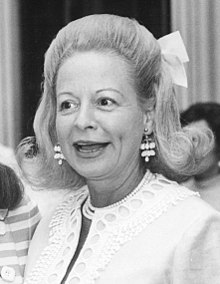Martha Mitchell
wife of American politician
Martha Elizabeth Beall Mitchell (September 2, 1918 – May 31, 1976) was the wife of John N. Mitchell, United States Attorney General under President Richard Nixon. Her public comments and interviews during the Watergate scandal led to the creation of The Martha Mitchell effect. This is when a psychiatrist mistakenly identifies a patient's true but extraordinary claims as delusions.[1] Her attempted lies about the Watergate scandal eventually led the press and investigators to uncover the truth behind the scandal.[2]
Martha Mitchell | |
|---|---|
 Mitchell in 1969 | |
| Born | Martha Elizabeth Beall September 2, 1918 Pine Bluff, Arkansas, U.S. |
| Died | May 31, 1976 (aged 57) New York City, U.S. |
| Education | Stephens College, Missouri University of Arkansas, Fayetteville University of Miami (BA) |
| Known for | Watergate scandal The Martha Mitchell effect |
| Spouses | |
| Children | 2 |
Mitchell died on May 31, 1976 at a hospital in New York City from problems caused by multiple myeloma at the age of 57.[3]
References
change- ↑ "Beliefs About Delusions". The Psychologist. 6 (8): 418–422. August 2003. Archived from the original on 2022-04-30. Retrieved 2023-03-14.
Sometimes improbable patient reports are erroneously assumed to be symptoms of mental illness (Maher, 1988). The 'Martha Mitchell effect' referred to the tendency of mental health practitioners not to believe the experience of the wife of the American attorney general, whose persistent reports of corruption in the Nixon White House were initially dismissed as evidence of delusional thinking, until later proved correct by the Watergate investigation. Such examples demonstrate that delusional pathology can often lie in the failure or inability to verify whether the events have actually taken place, no matter how improbable intuitively they might appear to the busy clinician.
{{cite journal}}: Unknown parameter|authors=ignored (help) - ↑ McLendon, Winzola (1979). Martha: The Life of Martha Mitchell. ISBN 9780394411248.
- ↑ "Martha Mitchell dies of rare bone cancer". Eugene Register-Guard. New York. UPI. May 31, 1976. p. 1A.